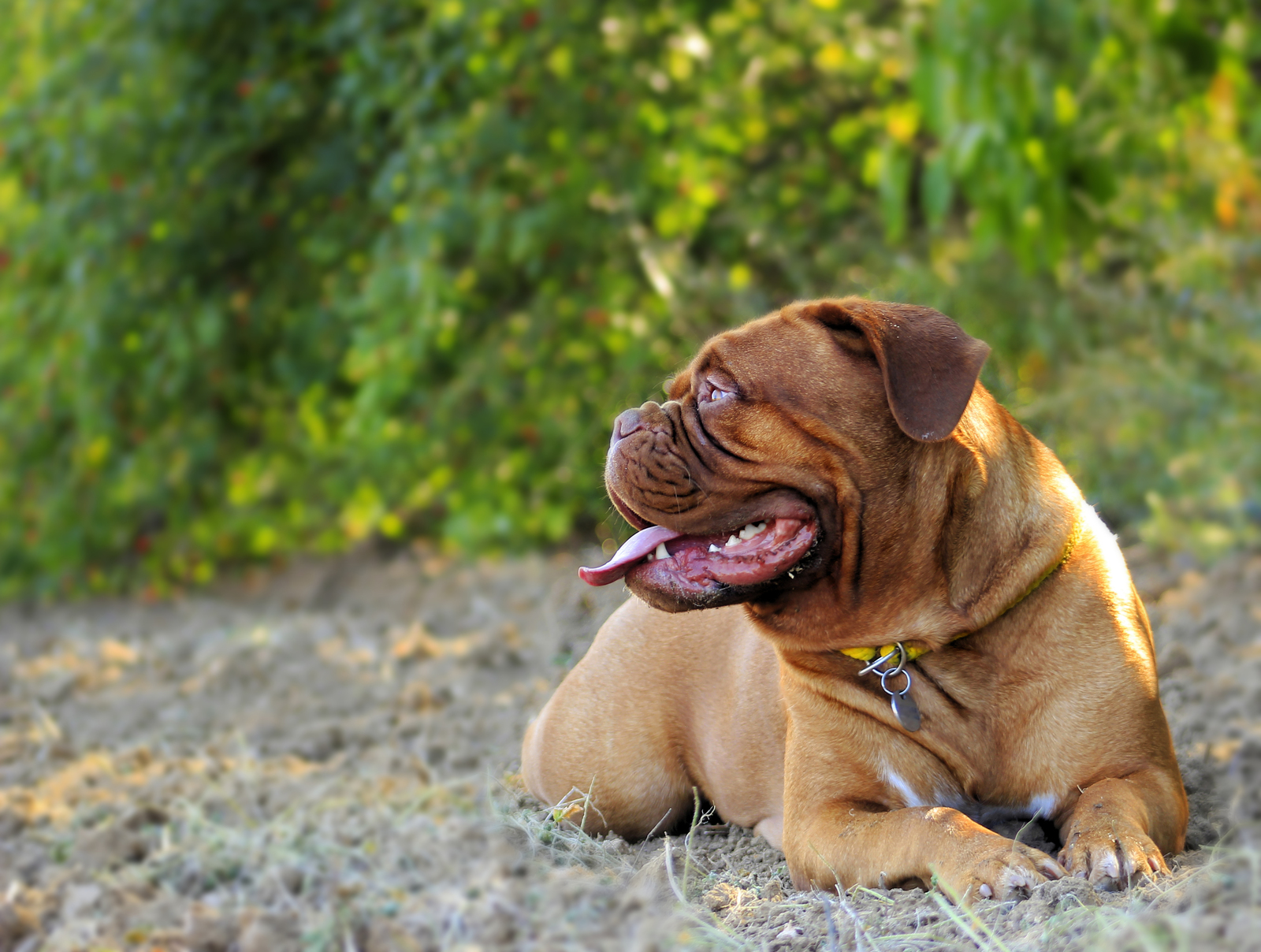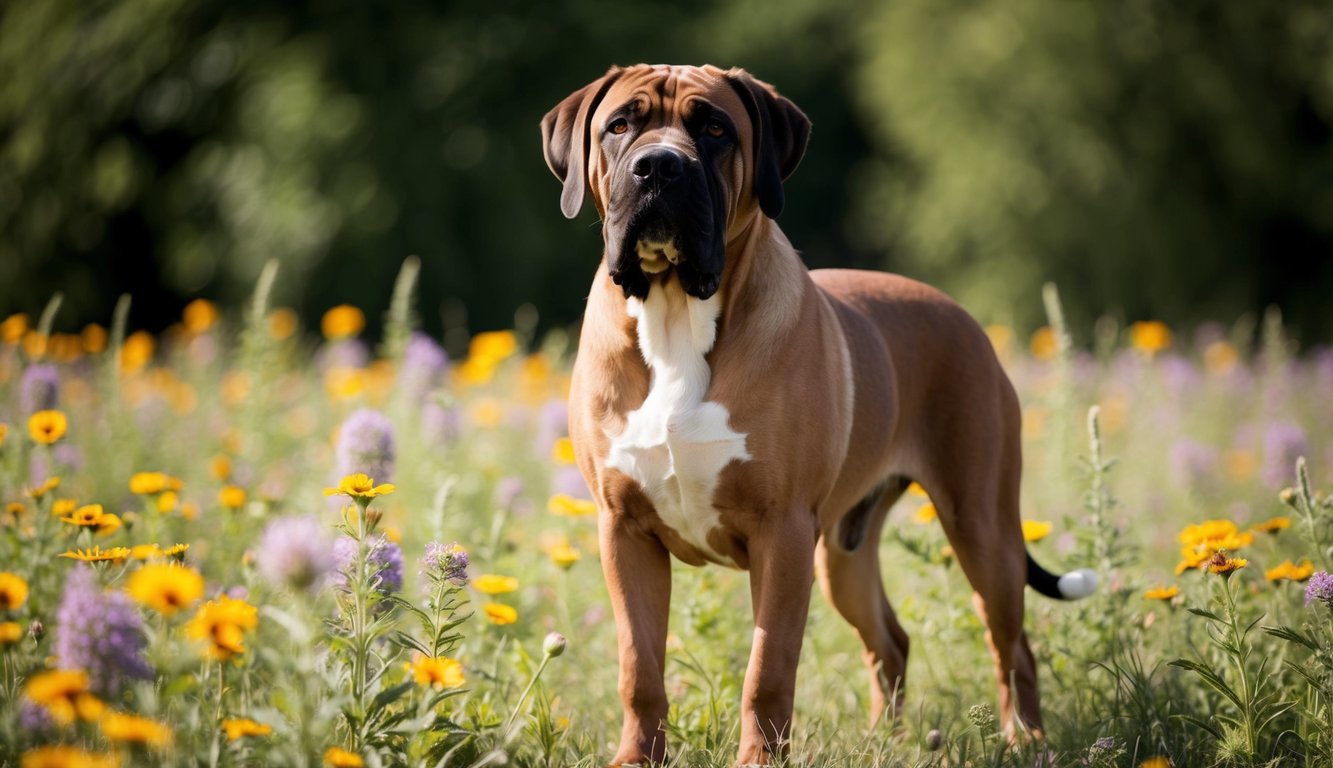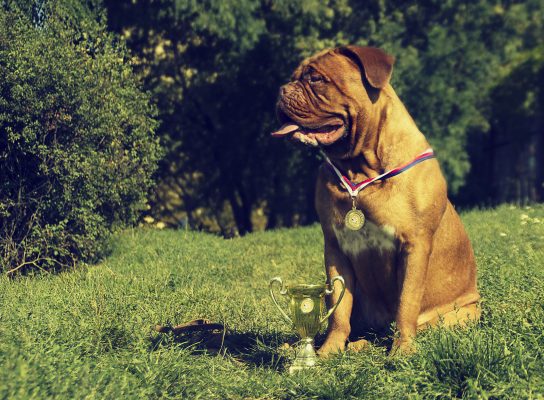The Dogue de Bordeaux and Mastiff are both ancient breeds with rich histories. These gentle giants share roots in the Molosser dog family. The Dogue de Bordeaux, also known as the French Mastiff, hails from France. Its origins can be traced back to the Bordeaux region, where it served various roles throughout history. Mastiffs have an even longer lineage. The English Mastiff’s ancestry dates back to 700 BC in China. These powerful dogs were prized for their strength and size.
Let’s explore the similarities and differences of both dog breeds. And, if you’re still on the market to buy one of these breeds, PuppySpot currently offers a $300 discount using the code PUPPY300, just click the banner below!
Physical Characteristics
The Dogue de Bordeaux and Mastiff are both large, powerful breeds with distinct physical features. These dogs have massive heads, loose skin, and impressive statures that set them apart from other canines.
Size and Stature
- Dogue de Bordeaux dogs are large and muscular, standing tall with a proud appearance. They typically reach heights of 23-27 inches at the shoulder. Males weigh 110-150 pounds, while females are 99-130 pounds.
- Mastiffs are even larger. They stand 27-30 inches tall and weigh 120-230 pounds. Their massive size makes them one of the biggest dog breeds.
- Both breeds have broad chests, strong legs, and thick necks. Their large size gives them an imposing presence.
Coat and Appearance
- The Dogue de Bordeaux has a short, fine coat that feels soft to the touch. Common colors include various shades of fawn to mahogany. Some have white patches on the chest and paws.
- Mastiffs sport short, dense coats that come in fawn, apricot, or brindle. They often have black masks on their faces.
- Both breeds have loose, wrinkled skin, especially around their faces and necks. This feature, along with their brachycephalic (flat-faced) skull shape, contributes to their distinctive looks. Their heads are notably large compared to their bodies, with wide muzzles and droopy jowls.

Temperament and Behavior
The Dogue de Bordeaux and Mastiff are known for their gentle nature and protective instincts. Both breeds have unique temperaments that shape their interactions with families and other pets.
Comparison of Dispositions
- The Dogue de Bordeaux is loyal and affectionate towards its family. They can be stubborn at times but are generally easygoing. These dogs are vigilant and make excellent watchdogs.
- Mastiffs are similarly gentle and loving. They are known for their calm demeanor and patience. Both breeds can be wary of strangers, but Mastiffs tend to be more reserved.
- Early socialization is crucial for both breeds. It helps them become well-adjusted adult dogs. Without proper training, their large size can lead to behavioral issues.
Interaction With Families and Other Pets
- Both breeds are great family dogs. They are gentle with children and form strong bonds with their families. The Dogue de Bordeaux can be more energetic and playful compared to the typically laid-back Mastiff.
- With other pets, proper introductions are important. Both breeds can get along well with other dogs and cats if socialized early. However, their strong protective instincts may cause issues with unfamiliar animals.
- Supervision is key when these gentle giants interact with smaller pets or young children. Their large size means they might accidentally knock over small kids during play.
Training and Socialization
Both Dogue de Bordeaux and Mastiffs need early training and socialization. These big dogs can be stubborn, so starting young is key. Positive methods work best for these gentle giants.
Puppy Training Essentials
- Early training is crucial for Dogue de Bordeaux and Mastiff puppies. Start with basic commands like sit, stay, and come. Keep sessions short and fun to hold their attention.
- Use treats and praise to reward good behavior. These breeds respond well to positive reinforcement. Avoid harsh corrections, which can damage trust.
- Consistency is vital. Set clear rules and stick to them. All family members should follow the same training approach.
- Crate training helps with housebreaking and provides a safe space. Introduce the crate gradually and make it a positive experience.
Socialization Techniques
- Expose puppies to various people, animals, and situations early on. This helps prevent fear or aggression later in life.
- Take them on short trips to different places. Let them meet friendly dogs and people. Always supervise these interactions.
- Puppy classes offer great socialization opportunities. They also teach basic obedience in a controlled setting.
- At home, introduce new objects, sounds, and textures. This builds confidence and reduces fear of the unknown.
- Invite friends over to meet the puppy. Teach children how to interact safely with the dog.
Health and Care
Both breeds face certain health challenges but can thrive with proper care. Regular vet checkups and a healthy lifestyle are key to keeping these gentle giants happy and healthy.
Common Health Challenges
- The Dogue de Bordeaux and Mastiff are prone to some similar health issues. Hip dysplasia is a concern for both breeds, affecting their mobility as they age.
- Bloat is another serious risk, especially for deep-chested dogs like these. It’s a life-threatening condition that requires immediate vet care.
- Both breeds may develop cancer and heart problems. Regular screenings can help catch these issues early.
- Allergies are common in both breeds. They may show up as skin irritations or digestive problems.
- The Dogue de Bordeaux typically has a shorter lifespan of 8-10 years, while Mastiffs often live 10-12 years.
Routine Care and Preventative Measures
- Regular vet checkups are crucial for both breeds. These visits help catch health issues early.
- A healthy diet is key. Feed them high-quality food suitable for large breeds. Watch their weight to prevent extra stress on joints.
- Exercise is important but should be moderate. Too much can strain their joints, especially when young.
- Brush their teeth regularly to prevent dental issues. Clean their ears weekly to avoid infections.
- Keep their living area clean and dry. This helps prevent skin problems common in both breeds.
- Watch for signs of bloat, like restlessness or a swollen belly. If spotted, seek vet care right away.
Exercise and Activity Needs
The Dogue de Bordeaux and Mastiff have different exercise needs. Both breeds benefit from regular activity to stay healthy and happy.
Maintenance of Physical Health
- Dogue de Bordeaux dogs need low to moderate exercise. A daily 30-minute walk is usually enough. These dogs don’t require intense workouts due to their large size and flat faces.
- Mastiffs have slightly higher energy levels. They enjoy medium amounts of exercise. A 45-60 minute walk each day keeps them fit. Mastiffs can handle more activity than Dogues de Bordeaux.
- Both breeds should avoid exercising in hot weather. Their large bodies make them prone to overheating. Short play sessions and indoor activities work well on warm days.
Mental Stimulation and Play
- Mental exercise is key for both breeds. Puzzle toys and training games keep their minds sharp. This prevents boredom and unwanted behaviors.
- Gentle play suits these big dogs best. Tug-of-war and fetch are fun options. Swimming can be a good low-impact activity for both breeds.
- Dogues de Bordeaux enjoy calm playtime. They like lounging and cuddling after short bursts of activity. Mastiffs are more playful. They often stay active for longer periods.
- Both breeds need early socialization. This helps them interact safely with people and other dogs during playtime.
Grooming Requirements
Both Dogue de Bordeaux and Mastiffs have specific grooming needs. Their short coats and facial folds require regular care to keep them healthy and comfortable.
Basic Grooming Overview
- Dogue de Bordeaux and Mastiffs have short, smooth coats that shed year-round. They need regular brushing to remove loose hair and keep their coats shiny. A rubber curry brush or grooming mitt works well for this task.
- Both breeds should be bathed every 4-8 weeks, depending on their activity level. Overbathing can dry out their skin, so it’s best to stick to a schedule.
- Their nails need trimming every 2-4 weeks. Regular ear cleaning helps prevent infections.
- Dental care is important for these large breeds. Brush their teeth 2-3 times a week to maintain good oral health.
Special Considerations for Skin Folds
- The facial folds of Dogue de Bordeaux and Mastiffs require extra attention. These areas can trap moisture and bacteria, leading to skin irritations or infections if not properly cared for.
- Clean the folds daily with a damp cloth or pet wipe. Dry thoroughly to prevent moisture buildup. Some owners use a gentle, pet-safe powder to keep the folds dry.
- Check the folds regularly for signs of redness, odor, or discharge. These could indicate an infection needing veterinary care.
- During baths, make sure to clean between the folds gently but thoroughly. Rinse well and dry completely to prevent skin issues.

Adaptability and Living Conditions
Both the Dogue de Bordeaux and Mastiff are large breeds that can adapt to different living situations with proper care and training. Their size and needs require some special considerations.
Suitability to Various Homes
- The Dogue de Bordeaux and Mastiff can adjust to apartment living if given enough exercise. They don’t need huge yards, but do best with some outdoor space. Both breeds are calm indoors and make good family pets.
- These dogs are protective of their families. Their size can be intimidating to strangers. Early socialization helps them be friendly with visitors.
- Mastiffs and Dogues de Bordeaux are sensitive to extreme temperatures. They need shelter from heat and cold.
Adjustments for Large Breeds
Owners must “dog-proof” their homes for these giant breeds. This includes:
- Removing fragile items from low surfaces
- Using sturdy furniture
- Installing baby gates on stairs
Both breeds drool a lot. Keeping towels handy helps with cleanup. Their short coats shed moderately and need weekly brushing. These dogs need space to move around comfortably indoors. Large, cushioned beds give them a cozy place to rest. Daily walks are important, but puppies shouldn’t over-exercise. This can harm their growing joints.



